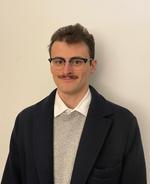
Contatti
Presso
- Cultural heritage and historical-artistic, audiovisual and multimedia production
- Dottorato in Patrimonio Culturale e produzione storico-artistica, audiovisiva e multimediale
Temi di ricerca
Francesco Sosso graduated from the University of Turin, earning a Bachelor’s Degree in History with the biography of a Piedmontese patriot, Pier Alessandro Garda. He then continued his studies with a Master's Degree in “Scienze Storiche” with a thesis about Risorgimento’s Material History.
His main area of interest is the Long Nineteenth Century, preferring broad-spectrum readings. Within the XIX Century, he focuses on Political History, History of the Institutions and, more generally, Cultural History.
The physical space of politics. Palazzo Carignano seat of the Chamber of Deputies of the Kingdom of Sardinia and the Kingdom of Italy
The main objective of the research is to reconstruct as completely as possible the political life inside and around Palazzo Carignano when it hosted the Chamber of Deputies.
The analysis will begin with the date of institution of the Parlamento Subalpino in 1848. Although Turin was no longer the Capital of the Kingdom after 1864-65, it is necessary to extend the analysis until at least the beginning of the 1870s, when it was completed the construction of the wing that should have housed the new Italian Chamber.
Tutor: Professoressa Silvia Cavicchioli (Università di Torino)
Cotutor: Professore Gian Luca Fruci (Università di Pisa)
Objectives and Themes
The two main themes analyzed will be parliamentary activity and its physical and institutional container. This combination allows to highlight some major transversal issues.
Firstly, the birth and development of both the parliamentary institution, its functioning and its specific political dialectic.
Secondly, we will study the people who in various capacities gravitated around Palazzo Carignano. This includes the internal staff, such as the deputies themselves, but also the members of the apparatus that allowed parliament to function (secretaries, messengers, stenographers, etc.). Also the "external spectators" of the parliamentary spectacle, such as the public, the foreign ambassadors and the journalists, will be studied.
Finally, the host building will be examined, reconstructing its spaces and areas and evaluating the influences that its architectural form has had on the parliamentary function.
Sources
Excluding historiography and subsequent reflections, the sources of the time can be divided into two broad categories: internal sources and sources external to Parliament.
Internal or official sources include all documents produced directly by the Chamber of Deputies or, more generally, by other central institutions of the State: parliamentary regulations, minutes of sessions, bills (approved or not), petitions, various appeals, etc.
The external sources include both individual and private accounts (diaries, correspondence and, to a limited extent, also memoirs) and public of parliamentary activity, which very quickly fed a multifaceted "parliamentary account" (novels, prints, images and newspaper articles).
Attività in agenda




